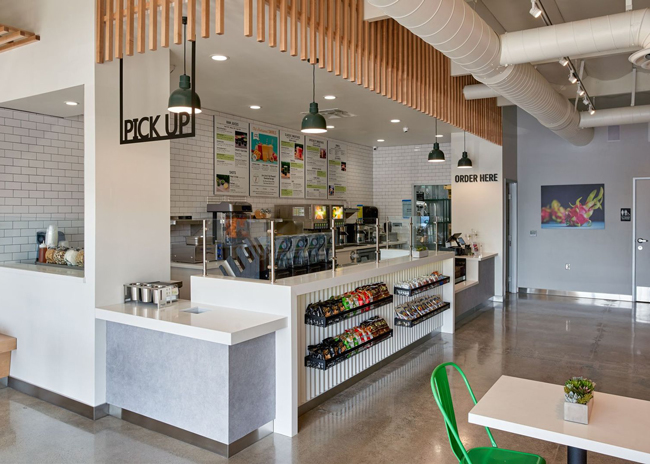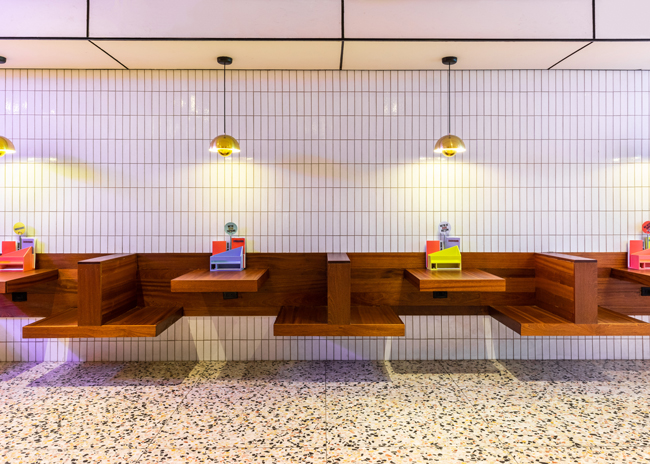Opening a new restaurant with a beautiful and memorable design is an expensive proposition. But there are ways to make a big impact in key areas while keeping the budget in check in others. Here, designers share their thoughts on what’s worth the splurge and what’s better approached with cost in mind.
The easiest way to keep budgets in check is to start with options, says Keith Short, design principal, Fishman & Associates, Venice, Fla. He starts with a “bells and whistles” option on everything, then offers a second choice for places where operators can cut costs. “We resort to the second one all the time,” he says.
Carrie Dessertine, principal, Mey & Co., Portland, Me., tries to impress on her clients from the start that they’re likely not going to get everything they want. She talks to them about their ideal design and what is nonnegotiable. “They might not get their living, breathing restaurant right out of the gate; it may be a work in progress,” she says. She gives three choices for every element of the design, then the owner can decide which pieces to splurge on and where to dial costs down.
Reuse
Utilizing a second-generation restaurant space is a solid way to keep costs in check. That’s because clever teams reuse as much as they can. This includes the façade and the kitchen equipment, particularly the hood, which can be a huge cost-saver even if you put brand new equipment underneath it, says Joy Dayaw, design project manager, MG2 Design, Seattle. But, she warns, “you have to do a lot of due diligence, especially on the hood.”
Existing floors often don’t need a lot of work done to them, though Dayaw warns that you should check for cracks in the slab and ensure that the slab is even.
Floors often need a simple — and inexpensive — refinish, says Cynthia Steinbrecher, principal, Davis Partnership Architects, Denver. “Floors anchor a space. They should feel effortless, tactile and timeless. I gravitate toward polished concrete for its raw, architectural beauty and durability — it’s high-impact without the high cost.”
Large-format porcelain tiles mimic natural stone but are more budget-friendly and easier to maintain. Luxury vinyl plank (LVP) is another go-to for its versatility and resilience; it can bring warmth and depth without the upkeep of hardwood. In key areas, Steinbrecher says, “a bold inset tile moment or painted floor pattern adds an artful touch without overwhelming the budget.”
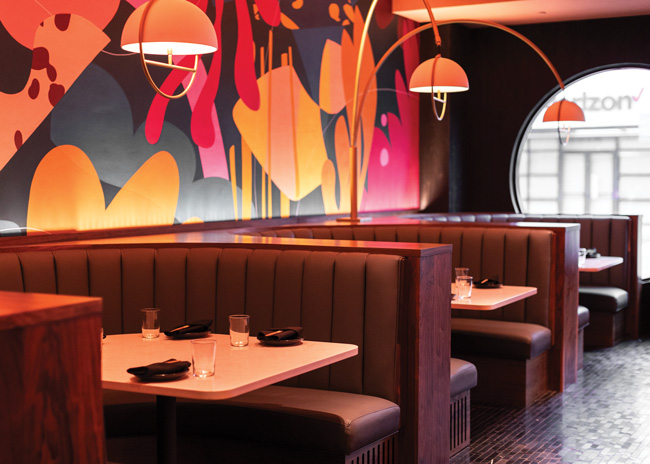 Floors anchor a space and need simple, inexpensive finishes like this mosaic stone Cynthia Steinbrecher used in Ro Hyde Park in Tampa, Fla. Images of Lola 41 locations courtesy 3 Oaks Hospitality
Floors anchor a space and need simple, inexpensive finishes like this mosaic stone Cynthia Steinbrecher used in Ro Hyde Park in Tampa, Fla. Images of Lola 41 locations courtesy 3 Oaks Hospitality
Front and Entrance
Designers can keep budgets under control on the exterior design of a restaurant by simply adding some striking signage, says Dayaw. And a fresh coat of paint is also inexpensive but can elevate the outside, which, she says, ties it into the brand and provides some context for the signage.
It may be a very small detail but using good door hardware is worth the splurge, says Dessertine. “People touch it and pay attention. That front door is important and can set a tone that aligns with what you’ll experience inside.”
Entrances and vestibules are also very important for the same reason, says Traci Weems, principal at GTM Architects, Bethesda, Md., and should create a great first impression.
But there are still ways to keep costs down. Look for inexpensive host stands online, Weems says, “which can be very economical, and no one is any the wiser that it’s from Wayfair. You might not spend a lot on the host stand but then elevate it by putting a stunning light over it, and guests will assume the desk is as good a quality as the light.”
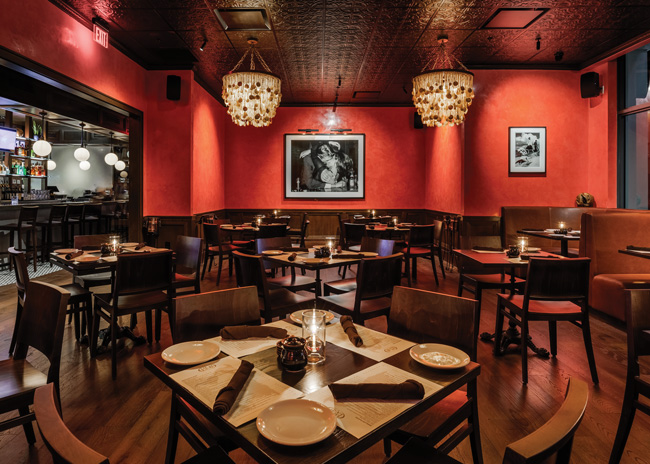 Keith Short recommends giving clients two options for everything — a top of the line choice and a budget-friendly selection. Image of Lola 41, Naples, Fla., courtesy of Ovi Mustea
Keith Short recommends giving clients two options for everything — a top of the line choice and a budget-friendly selection. Image of Lola 41, Naples, Fla., courtesy of Ovi Mustea
Bar Focus
Bars are not the place to cut costs because they provide a big statement when guests walk in. “It’s meant to be very memorable; you want everyone to look at the bar, you want high drama,” says Dayaw.
The most important elements of the bar are the bar top, which gets noticed and touched a lot, and the back bar, which can often be seen throughout the restaurant and creates ambiance and lighting. The bar is also a good place to splurge on lighting.
Where you can save money is on the bar front, says Weems, because there are always people and bar stools in front of it. She prefers to use wood plank finish (even a flooring product, especially good for durability), plastic laminate or tile. “There are so many options at lower price points and since it is not directly exposed or in a high contact area you don’t need a high-cost tile here.”
Bathroom Break
Bathrooms are often afterthoughts or designed to meet the bare minimum ADA requirements. However, bathrooms are a perfect place to be strategic and make a big impact within a small space, says Steinbrecher. She likes to utilize large-format tiles, which cut down on labor costs but still feel sleek and seamless, and she likes to elevate prefabricated vanities with custom hardware and upgraded lighting.
The design and finishes in a restaurant’s bathrooms should be as thought-out as the front of house, says Dessertine: “It’s where everyone is alone so they’re paying more attention to their surroundings.”
And small things can make a big difference. “A single statement mirror, an unexpected wall color, or a bold sconce can bring a sense of luxury without an expensive overhaul,” says Dessertine. “Even small details like a well-placed ledge for amenities or a contrasting grout color can feel thoughtful and high-design while staying within budget.”
Since restrooms are small spaces, Weems recommends deciding what the focal point is and spending money there. Focal points could be a fun tiled accent wall, artwork on a neutral (i.e. inexpensive) wall, a fun floor tile, a cool countertop or unique wall sconces. “You want one thing that stands out for people to remember and tell someone about,” she says.
An easy way to keep the budget down in the bathroom, Weems adds, is by stopping the wall tile between 42 and 72 inches high and using a less expensive material above like paint or wallcovering.
A straightforward way to conserve the budget is to use the existing plumbing so you don’t need to dig up the slab, says Dayaw, and then you can use your budget for things that make a difference like accessories, lighting and finishes. And you can have some fun in bathrooms with even a limited budget. Dayaw points to some dog tail hooks she included in a restaurant that was themed around a show dog.
Lighting Effects
Most restaurants benefit from a standout light fixture that draws the eye, but the rest of the lighting could almost fade away to illuminate the restaurant correctly without being noticed.
“Lighting is about creating layers and balance is everything,” says Steinbrecher. “A showstopping fixture in the private dining room or bar makes a statement, while the rest of the lighting works subtly to shape the experience.”
Steinbrecher likes to use linear LEDs and concealed cove lighting to bring depth without a lot of cost, and wall sconces or simple pendant groupings to add intimacy at a fraction of the cost of custom fixtures. Reflective surfaces — mirrors, metallics, even glossy tiles — can amplify light, she says, “making a space feel luminous without excess fixtures. It’s all about creating atmosphere with intention.”
 Carrie Dessertine likes small lighting moments that are less expensive than a large eye-catching chandelier. Image of Bread & Friends, Portland, Me., courtesy of Nicole WolfAn easy way to keep costs down with lighting is to buy it all through one company or one manufacturer. They typically offer better pricing for a full package and this also curtails options “because otherwise the possibilities are endless,” Weems explains. “Pick your top two or three fixtures and invest the money in those as a focal point and the rest can be neutral or background.”
Carrie Dessertine likes small lighting moments that are less expensive than a large eye-catching chandelier. Image of Bread & Friends, Portland, Me., courtesy of Nicole WolfAn easy way to keep costs down with lighting is to buy it all through one company or one manufacturer. They typically offer better pricing for a full package and this also curtails options “because otherwise the possibilities are endless,” Weems explains. “Pick your top two or three fixtures and invest the money in those as a focal point and the rest can be neutral or background.”
Dessertine prefers smaller lighting moments that create intimate nooks versus a huge eye-catching chandelier. “It’s better to find one really sweet little fixture and repeat it for lots of smaller moments,” she says.
Bon Delire, a French bistro in San Francisco, features some vintage 1960s German blown glass lights — two pendants and three wall sconces. They’re amber glass so create organic patterns on the walls. Brett Terpeluk, principal, Studio Terpeluk, San Francisco, says they were relatively expensive, forcing him to “remove some additional design elements to allow for the purchase of the lights.”
Buy Vintage
Not everything needs to be new. Sometimes sourcing vintage items can lead to standout pieces, such as when Steinbrecher found a vintage bar from the 1950s, that was “heavy, oak, overly ornate,” she says, which she used in a speakeasy. She found it in a second-hand store, together with a front entry piece of furniture. Together, the two pieces cost $8,000, whereas a more typical cost for these items purchased new would be $50,000, she says.
Steinbrecher likes to source vintage items in antique stores and websites like eBay and she looks for “anything that’s a bit different, that you haven’t seen over and over again.” These, she says, “really get that high impact effect without a lot of cost and really give a place its own ethos.”
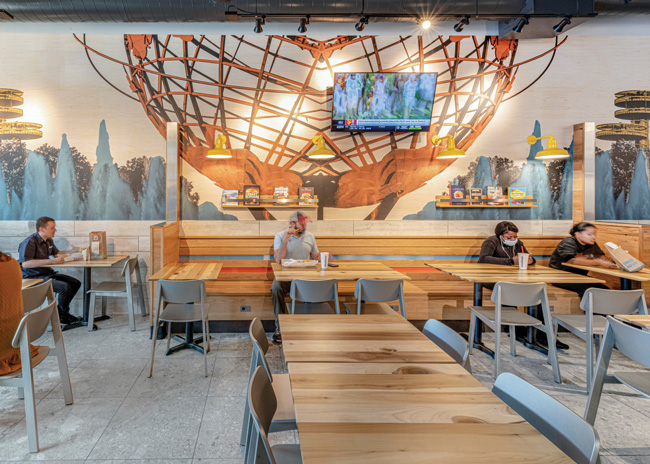 The large graphic wallcovering at Smashburger in Queens, N.Y., designed by MG2, Seattle, is a bold branding statement but less expensive than an artist’s mural. Image courtesy of Andrew Werner
The large graphic wallcovering at Smashburger in Queens, N.Y., designed by MG2, Seattle, is a bold branding statement but less expensive than an artist’s mural. Image courtesy of Andrew Werner
Artwork Alignment
Artwork is an essential element of any restaurant’s interior design to give “a welcoming touch,” says Steinbrecher. She likes to “mix high- and low-investment pieces where they matter,” but also features prints, layered textures, or murals that create impact without breaking the budget. She keeps a digital and paper archive of artwork for inspiration.
She’s always looks into emerging and local artists first, then auctions, online platforms (like Saatchi Art, Singulart, and Artsy), and even vintage shops that “offer one-of-a-kind finds that don’t have to be expensive to feel high-end.” She adds that murals and custom graphics are also a brilliant way to create a statement wall with a big visual return. And she likes to make art stand out without breaking the bank by putting it into interesting frames, she says, which can provide lots of visual interest and textures, especially if she creates a gallery wall. Adding a simple mat to a picture and frame can also elevate the piece significantly, she points out.
Short likes to source locally, to keep shipping costs down. He also likes to borrow artwork from local galleries that are willing to showcase their art or sculptures. “This tends to keep the art evolving within the space, to create variety for seasonal diners,” he points out.
When sourcing outside the country, Short pays a lot of attention to exchange rates and tariffs. In this, he says, he embraces the mindset of a day trader and periodically checks the price of the specific item and cross checks with a similar product found locally. This way, he says, he can lock in “the price, terms and conditions, and freight early with a significant deposit and pay the balance on receipt as per the confirmed quotation.”
Finishes and Furniture
Nice finishes can make a big difference in restaurant design, but Weems keeps costs down by keeping the finishes the same throughout a space. “Every time you transition to a different finish, there are costs with that. And, there is something beautiful about simplicity and some truth to less is more,” she says.
Weems suggests starting with a base of minimal finishes and supplementing them with items like artwork and vases. You’ll also get a discount for buying finishes in bulk, she says, and keeping the finishes the same cuts down on the contractors the buildout requires — different materials often need different contractors to install them.
Custom pieces of furniture or lighting look fabulous but can drive costs up. Weems is a fan of custom host stands to make a great first impression but less so for custom chairs, because there are so many
of them.
Weems like to create a custom back bar “since people are looking directly at it and often it is visible when you walk into the space.” She likes to tailor these to how the client wants to display bottles.
With custom pieces, “it’s about choosing your moment,” says Dessertine. “You have to pick and choose what will make the most impact. Often for restaurants it’s table tops and lighting.”

